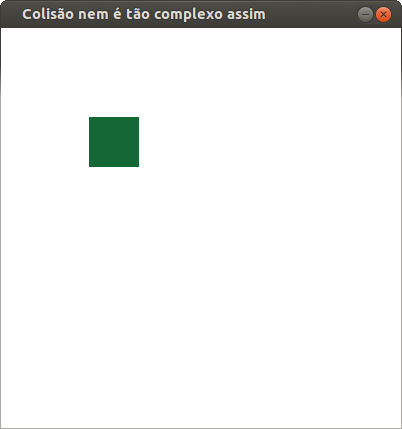Tutorial OpenGL v2.0
Finalmente chegou! Após quase 1 ano depois de meu primeiro artigo sobre OpenGL, chegou a versão 2.0. Clique e fique mais Geek.
[ Hits: 20.260 ]
Por: Thiago Henrique Hüpner em 08/05/2015
A jornada é longa parte 1 - Colisão Mouse e Retângulo
Esse é o maior 'medo' dos iniciantes e é o que deixa as coisas mais interessantes, mas para melhorar, saiba que não é tão complexo assim (bom , essa parte).
Essa colisão de Mouse e Retângulo também é conhecida como Colisão de um Ponto e um Retângulo. Exemplo:
#include <SDL/SDL.h>
#include <SDL/SDL_opengl.h>
#include <time.h>
#define LARGURA 400
#define ALTURA 400
int colisao(int x,int y,SDL_Rect a){
// É verificado primeiro no eixo X
if(x >= a.x && x <= a.x + a.w){
// Depois no eixo Y
if(y >= a.y && y <= a.y + a.h){
// Se aconteceu a colisão irá retornar 1
return 1;
}
}
// Se passou pelos if's e não retornou significa que nao houve colisao
return 0;
}
void inicializaOpenGL(){
glClearColor(255,255,255,1);
glMatrixMode(GL_PROJECTION);
glLoadIdentity();
gluOrtho2D(0,LARGURA,ALTURA,0);
glMatrixMode(GL_MODELVIEW);
glClear(GL_COLOR_BUFFER_BIT);
}
// Simulando o SDL_FillRect
void GL_FillRect(SDL_Rect a,int r,int g,int b){
glClear(GL_COLOR_BUFFER_BIT);
glLoadIdentity();
glColor3ub(r,g,b);
glBegin(GL_QUADS);
// Lado Superior Esquerdo
glVertex2f(a.x,a.y);
// Lado Superior Direito
glVertex2f(a.x+a.w,a.y);
// Lado Inferior Direito
glVertex2f(a.x+a.w,a.y+a.h);
// Lado Inferior Esquerdo
glVertex2f(a.x,a.y+a.h);
glEnd();
}
int main(int argc,char *argv[]){
if(SDL_Init(SDL_INIT_VIDEO) < 0){
printf("Erro : %s
",SDL_GetError());
return -1;
}
// Para sempre ter valores pseudo-aleatorios
srand((unsigned)time(NULL));
SDL_GL_SetAttribute( SDL_GL_RED_SIZE, 8 );
SDL_GL_SetAttribute( SDL_GL_GREEN_SIZE, 8 );
SDL_GL_SetAttribute( SDL_GL_BLUE_SIZE, 8 );
SDL_GL_SetAttribute( SDL_GL_ALPHA_SIZE, 8 );
SDL_GL_SetAttribute( SDL_GL_DOUBLEBUFFER, 2 );
SDL_Surface * tela = SDL_SetVideoMode(LARGURA,ALTURA,32,SDL_OPENGL);
if(tela == NULL){
printf("Erro : %s
",SDL_GetError());
SDL_Quit();
return -1;
}
SDL_WM_SetCaption("Colisão nem é tão complexo assim",NULL);
SDL_Event evento;
int estaRodando = 1;
SDL_Rect retangulo;
inicializaOpenGL();
int r = 255;
int g = 0;
int b = 0;
int posX = 10;
int posY = 10;
while(estaRodando){
while(SDL_PollEvent(&evento)){
switch(evento.type){
case SDL_QUIT:
estaRodando = 0;
break;
case SDL_MOUSEBUTTONDOWN:
if(evento.button.button == SDL_BUTTON_LEFT){
// Se apertar no botão esquerdo e o mouse estiver em cima do retangulo ...
if(colisao(evento.button.x,evento.button.y,retangulo)){
// Muda a cor R,G e B e consequentemente a cor do retangulo muda
// NOTA : Tem que ser 256 e não 256 , pois a chance de ser 255 é muito pequena e usando o 256 , a chance aumenta
// de ser 255
r = rand() % 256;
g = rand() % 256;
b = rand() % 256;
}
}else if(evento.button.button == SDL_BUTTON_RIGHT){
// Se apertar com o botão direito , o retangulo assume a posição do mouse
posX = evento.button.x;
posY = evento.button.y;
}
break;
default:
break;
}
}
// Propriedades do Retangulo
// Posição X
retangulo.x = posX;
// Posição Y
retangulo.y = posY;
// Aqui a coisa começa a ficar interessante ...
// Largura do Retangulo
retangulo.w = 50;
// Altura do Retangulo
retangulo.h = 50;
GL_FillRect(retangulo,r,g,b);
SDL_Delay(30);
SDL_GL_SwapBuffers();
}
SDL_Quit();
return 0;
}
Compile e execute esse código:
gcc -o ColisoesAtacar ColisoesAtacar.c -lSDL -lGL -lGLU
E após clicar no retângulo com os dois botões, ficou assim para mim (poderá ser diferente):

Agora vamos entender como o "if" trabalha:
Se a posição X do mouse for maior ou igual ao lado superior esquerdo do retângulo e for menor ou igual ao lado superior direito (a.x + a.w), colidiu. Agora, só nos resta detectar a colisão do eixo Y , que segue a mesma logica (até aqui).Agora um desafio: elabore um programa que tenha 3 (ou mais) retângulos e que se o usuário clicar no retângulo certo, ele muda de cor. Senão, o programa continuará sendo executado até que acerte.
Não é tão complexo assim, só é necessário pensar um pouco mais, mas nada difícil. Como existem várias formas de elaborar um mesmo programa, poderá ser diferente do meu, mas será a mesma lógica.
Eu elaborei esse programa a lá Thiago:
#include <SDL/SDL.h>
#include <SDL/SDL_opengl.h>
#include <time.h>
#define LARGURA 400
#define ALTURA 400
int colisao(int x,int y,SDL_Rect a) {
// É verificado primeiro no eixo X
if(x >= a.x && x <= a.x + a.w) {
// Depois no eixo Y
if(y >= a.y && y <= a.y + a.h) {
// Se aconteceu a colisão irá retornar 1
return 1;
}
}
// Se passou pelos if's e não retornou significa que nao houve colisao
return 0;
}
void inicializaOpenGL() {
glClearColor(255,255,255,1);
glMatrixMode(GL_PROJECTION);
glLoadIdentity();
gluOrtho2D(0,LARGURA,ALTURA,0);
glMatrixMode(GL_MODELVIEW);
glClear(GL_COLOR_BUFFER_BIT);
}
void definicoesRetangulo(int posX ,int posY,SDL_Rect * a) {
glClear(GL_COLOR_BUFFER_BIT);
// Propriedades do Retangulo
// Posição X
a->x = posX;
// Posição Y
a->y = posY;
// Aqui a coisa começa a ficar interessante ...
// Largura do Retangulo
a->w = 50;
// Altura do Retangulo
a->h = 50;
}
// Simulando o SDL_FillRect
void GL_FillRect(SDL_Rect a,int r,int g,int b) {
glLoadIdentity();
glColor3ub(r,g,b);
glBegin(GL_QUADS);
// Lado Superior Esquerdo
glVertex2f(a.x,a.y);
// Lado Superior Direito
glVertex2f(a.x+a.w,a.y);
// Lado Inferior Direito
glVertex2f(a.x+a.w,a.y+a.h);
// Lado Inferior Esquerdo
glVertex2f(a.x,a.y+a.h);
glEnd();
}
int main(int argc,char *argv[]) {
if(SDL_Init(SDL_INIT_VIDEO) < 0) {
// ... imprima a mensagem de erro e ...
printf("Erro : %s
",SDL_GetError());
return -1;
}
// Para sempre ter valores pseudo-aleatorios
srand((unsigned)time(NULL));
SDL_GL_SetAttribute( SDL_GL_RED_SIZE, 8 );
SDL_GL_SetAttribute( SDL_GL_GREEN_SIZE, 8 );
SDL_GL_SetAttribute( SDL_GL_BLUE_SIZE, 8 );
SDL_GL_SetAttribute( SDL_GL_ALPHA_SIZE, 8 );
SDL_GL_SetAttribute( SDL_GL_DOUBLEBUFFER, 2 );
SDL_Surface * tela = SDL_SetVideoMode(LARGURA,ALTURA,32,SDL_OPENGL);
if(tela == NULL) {
printf("Erro : %s
",SDL_GetError());
SDL_Quit();
return -1;
}
SDL_WM_SetCaption("Colisão nem é tão complexo assim",NULL);
SDL_Event evento;
int estaRodando = 1;
SDL_Rect r1,r2,r3;
inicializaOpenGL();
int r = 255;
int g = 0;
int b = 0;
while(estaRodando) {
while(SDL_PollEvent(&evento)) {
switch(evento.type) {
case SDL_QUIT:
estaRodando = 0;
break;
case SDL_MOUSEBUTTONDOWN:
if(evento.button.button == SDL_BUTTON_LEFT) {
// Se apertar no botão esquerdo e o mouse estiver em cima do retangulo (2) ...
if(colisao(evento.button.x,evento.button.y,r2)) {
// Muda a cor R,G e B e consequentemente a cor do retangulo muda
// NOTA : Tem que ser 256 e não 256 , pois a chance de ser 255 é muito pequena e usando o 256 , a chance aumenta
// de ser 255
r = rand() % 256;
g = rand() % 256;
b = rand() % 256;
}
}
break;
default:
break;
}
}
definicoesRetangulo(50,50,&r1);
definicoesRetangulo(150,50,&r2);
definicoesRetangulo(250,50,&r3);
GL_FillRect(r2,r,g,b);
GL_FillRect(r1,255,0,255);
GL_FillRect(r3,0,255,0);
SDL_Delay(30);
SDL_GL_SwapBuffers();
}
SDL_Quit();
return 0;
}
Salve e compile como quiser, é um desafio. Agora quem decide é você. =D
Como ficou o meu, após clicar no retângulo correto:

2. Inicializando o SDL
3. OpenGL e SDL botando pra quebrar
4. Simulando uma Gambiarra
5. A jornada é longa parte 1 - Colisão Mouse e Retângulo
6. A jornada é longa parte 2 - Colisão entre 2 Retângulos
7. "Imagine" seu programa
8. Agradecimentos, links úteis e fontes
Ubuntu/Debian/Kali Linux e outros no Android
Criando programas com suporte a arquivos de configuração com a libConfuse
Muito bom! Vou tentar criar um game simples pra minha filha ficar clicando no retângulo com a cor certa com base neste tutorial.
[1] Comentário enviado por fabio em 08/05/2015 - 10:30h
Muito bom! Vou tentar criar um game simples pra minha filha ficar clicando no retângulo com a cor certa com base neste tutorial.
Fábio, mais uma vez, muito obrigado !
E boa sorte com o aplicativo, espero que sua filha goste.
Qualquer dúvida só pedir =D
[]'s
T+
Bom artigo!
Favoritado e pega meu 10!
Até
[3] Comentário enviado por UmCaraAToa em 08/05/2015 - 11:25h
Bom artigo!
Favoritado e pega meu 10!
Até
Valeu fera
T+
Favoritado. Vou ler depois com calma. Mas só de dar uma olhada por rápida vi que é material interessante!
--
http://pastebin.com/aji5Qp05
[5] Comentário enviado por xerxeslins em 08/05/2015 - 11:49h
Favoritado. Vou ler depois com calma. Mas só de dar uma olhada por rápida vi que é material interessante!
--
http://pastebin.com/aji5Qp05
Valeu fera, Obrigado!
[]'s
T+
Parabéns pelo artigo escrito, é uns dos melhores (e únicos) artigos sobre OpenGL aqui no VOL.
[7] Comentário enviado por preroeb em 08/05/2015 - 19:02h
Parabéns pelo artigo escrito, é uns dos melhores (e únicos) artigos sobre OpenGL aqui no VOL.
Valew pela força!
Dando duro pra trazer um artigo de qualidade pra vocês, meu povinho do "Volzinho"!
[]'s
T+
Ae Parabéns brother excelente artigo , favoritado aqui tbm :)
Igor Felipe
Cadastrado desde: 25/09/2009
[b]If it moves , compile it.[/b]
[9] Comentário enviado por Felipeigor em 08/05/2015 - 19:43h
Ae Parabéns brother excelente artigo , favoritado aqui tbm :)
Igor Felipe
Cadastrado desde: 25/09/2009
[b]If it moves , compile it.[/b]
Valew Tambem pelo apoio!
[]'s
T+
Legal cara, bem explicada a parte sobre colisão. Um bom artigo como um todo. Parabéns.
[11] Comentário enviado por SamL em 09/05/2015 - 12:50h
Legal cara, bem explicada a parte sobre colisão. Um bom artigo como um todo. Parabéns.
Valew Sam! Sempre me apoiando!
[]'s
T+
Oi, Thiago!
Dei uma rápida lida no seu artigo.
Está muito bom!
Continue assim, com essas ótimas contribuições!
Ang,
Manaus, AM, Brasil.
Usuário de sistemas operacionais livres/abertos tipo Unix ou tipo DOS,
Distros Favoritas: FreeBSD, Free-DOS, , PC-DOS, Bodhi Linux, Ubuntu, Big Linux, Kurumim, OpenSUSE, Slackware e Slax.
[13] Comentário enviado por Ang em 09/05/2015 - 16:14h
Oi, Thiago!
Dei uma rápida lida no seu artigo.
Está muito bom!
Continue assim, com essas ótimas contribuições!
Ang,
Manaus, AM, Brasil.
Usuário de sistemas operacionais livres/abertos tipo Unix ou tipo DOS,
Distros Favoritas: FreeBSD, Free-DOS, , PC-DOS, Bodhi Linux, Ubuntu, Big Linux, Kurumim, OpenSUSE, Slackware e Slax.
Valew !
Obrigado por ter lido!
[]'s
T+
Patrocínio
Destaques
Artigos
Como atualizar sua versão estável do Debian
Cirurgia para acelerar o openSUSE em HD externo via USB
Void Server como Domain Control
Dicas
Script de montagem de chroot automatica
Atualizar Linux Mint 22.2 para 22.3 beta
Jogar games da Battle.net no Linux com Faugus Launcher
Como fazer a Instalação de aplicativos para acesso remoto ao Linux
Tópicos
Por que passar nas disciplinas da faculdade é ruim e ser reprovado é b... (7)
De volta para o futuro - ou melhor, para o presente (parte 2) (0)
Top 10 do mês
-

Xerxes
1° lugar - 147.751 pts -

Fábio Berbert de Paula
2° lugar - 66.610 pts -

Buckminster
3° lugar - 22.232 pts -

Mauricio Ferrari
4° lugar - 20.838 pts -

Alberto Federman Neto.
5° lugar - 19.906 pts -

edps
6° lugar - 18.812 pts -

Daniel Lara Souza
7° lugar - 17.892 pts -

Andre (pinduvoz)
8° lugar - 16.133 pts -

Alessandro de Oliveira Faria (A.K.A. CABELO)
9° lugar - 15.617 pts -

Jesuilton Montalvão
10° lugar - 14.908 pts




